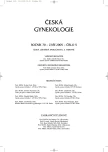The Perineal Body Length and Injury at Delivery
Authors:
V. Kališ; P. Chaloupka; Jakub Turek; Z. Rokyta
Authors‘ workplace:
Gynekologicko-porodnická klinika LF UK a FN Plzeň, přednosta doc. MUDr. Z. Rokyta, CSc.
Published in:
Ceska Gynekol 2005; 70(5): 355-361
Category:
Original Article
Overview
Objective:
Evaluation of mutual relationship between the perineal length, vaginal delivery and perineal injury.
Design:
Prospective study.
Setting:
Department of Gynaecology and Obstetrics, Charles University and Faculty Hospital Pilsen.
Methods:
318 women (92%) entered the study after their first vaginal delivery having given their consent. Instrumental vaginal deliveries were excluded. According to the perineal length, the women were divided into three study groups: short perineum (less or equal 30 mm), normal perineum (>30 mm and <60 mm), long perineum (equal to 60 mm and longer). Parameters evaluated: incidence of episiotomy, length of episiotomy, angle of episiotomy of the midline, shortest distance between episiotomy and anus, episiotomy and perineum length ratio. If episiotomy was not performed, the perineal tear has been evaluated in grades.
Results:
The total proportion of episiotomy makes up 75%. The proportion of episiotomy and its angle has not reached statistical significance amongst the study groups. The length of episiotomy has been statistically significant amongst all study groups – the shortest being in the group of short perineum and the longest in the group of long perineum (p=0.001). However the shortest distance between episiotomy and anus was statistically significant in the group of short perineum compared to normal perineum (p=0.026) and long perineum (p=0.005). If episiotomy was not performed, the total average perineal tear (in grades) was minimum in the group of short perineum and maximum in the group of long perineum (p=0.018).
Summary:
The short perineum does not appear to be the risk factor in the higher rate of episiotomy and perineal tears in this study. However if episiotomy was performed, the part of perineum which was not injured was found significantly shorter than in the other study groups. This could subsequently lead to postpartum anal incontinence. In this group the use of episiotomy as a prevention of perineal injury seems unjust. The group of long perineum has a significantly longer episiotomy and grade of perineal tear. This could contribute to the development of dyspareunia.
Key words:
perineal tear, perineal trauma, delivery, perineal body length, episiotomy
Labels
Paediatric gynaecology Gynaecology and obstetrics Reproduction medicineArticle was published in
Czech Gynaecology

2005 Issue 5
Most read in this issue
- The Perineal Body Length and Injury at Delivery
- Embolization of Uterine Arteries during Myoma Treatment from the Patient’s Point of View
- Antifungal Effect in Selected Natural Compounds and Probiotics and their Possible Use in Prophylaxis of Vulvovaginitis
- Does Oocyte Retrieval Influence the Following Morphological Quality of Embryos?
